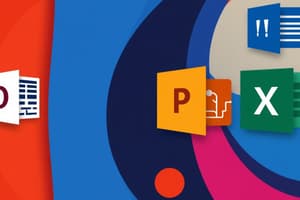Podcast
Questions and Answers
โปรแกรม Microsoft Word ใช้สำหรับอะไร?
โปรแกรม Microsoft Word ใช้สำหรับอะไร?
- สร้างภาพถ่าย
- สร้างสเปรดชีต
- สร้างเอกสาร (correct)
- สร้างงานด้วย PowerPoint
Excel ใช้งานได้อย่างไร?
Excel ใช้งานได้อย่างไร?
- ออกแบบโปสเตอร์
- จัดเก็บข้อมูลแบบฐานข้อมูล
- แก้ไขภาพ
- สร้างแผนภูมิและกราฟ (correct)
คุณสามารถใช้ Microsoft Excel เพื่อทำอะไร?
คุณสามารถใช้ Microsoft Excel เพื่อทำอะไร?
- ออกแบบเว็บไซต์
- จัดเก็บข้อมูลและทำการคำนวณ (correct)
- ส่งอีเมล
- ขับกระบวนการทำความสะอาด
Microsoft Office ประกอบด้วยโปรแกรมประมวลผลคำใด?
Microsoft Office ประกอบด้วยโปรแกรมประมวลผลคำใด?
โปรแกรม Microsoft Excel สามารถใช้ในการจัดเก็บข้อมูลได้อย่างไร?
โปรแกรม Microsoft Excel สามารถใช้ในการจัดเก็บข้อมูลได้อย่างไร?
คุณสามารถใช้ Microsoft Word สำหรับการทำอะไร?
คุณสามารถใช้ Microsoft Word สำหรับการทำอะไร?
PowerPoint เป็นซอฟต์แวร์ที่ใช้สร้างอะไร?
PowerPoint เป็นซอฟต์แวร์ที่ใช้สร้างอะไร?
Access เป็นระบบจัดการฐานข้อมูลที่ทำอะไร?
Access เป็นระบบจัดการฐานข้อมูลที่ทำอะไร?
One Note เป็นแอปที่ออกแบบมาเพื่อใช้ทำอะไร?
One Note เป็นแอปที่ออกแบบมาเพื่อใช้ทำอะไร?
Visio เป็นเครื่องมือที่ให้การสนับสนุนในงานใด?
Visio เป็นเครื่องมือที่ให้การสนับสนุนในงานใด?
Microsoft Office รุ่นแรกปล่อยตัวข้อไหน?
Microsoft Office รุ่นแรกปล่อยตัวข้อไหน?
Outlook เป็นโปรแกรมที่ใช้งานสำหรับการ?
Outlook เป็นโปรแกรมที่ใช้งานสำหรับการ?
Flashcards are hidden until you start studying
Study Notes
Microsoft Office - A Comprehensive Overview
Microsoft Office is a suite of productivity applications designed by Microsoft Corporation for Windows and macOS operating systems. It includes various components such as Word, Excel, PowerPoint, Outlook, Publisher, Access, OneNote, Project, Visio, Infopath Forms Services, Sharepoint Designer, Skype for Business Server, and Lync Server. Each application within this suite has its unique features to help users create, organize, share, and analyze information effectively.
Key Applications Within Microsoft Office Suite
Microsoft Word
Word is a word processing program used for creating documents like letters, reports, resumes, etc., with formatting options, templates, and tools. It allows you to type text, insert images, tables, charts, and more into your document. Additionally, it provides spell check, grammar correction, and auto-correct functionality to ensure accurate writing.
Microsoft Excel
Excel is primarily known as a spreadsheet program where data can be organized, stored, analyzed, and presented using cells, rows, columns, and formulas. Its primary functions involve storing data, performing calculations, generating graphs, creating pivot tables, sorting data, filtering data, etc.. Excel also supports macros, which are small programs written in VBA (Visual Basic for Applications) programming languages, enabling users to automate repetitive tasks.
Microsoft PowerPoint
PowerPoint is a presentation software tool that helps users design professional presentations with slides containing graphics, animations, videos, music, sound effects, narrations, etc. It offers different slide layouts, themes, font styles, transitions between slides, and other aesthetically pleasing designs. Users can save their presentations locally or on cloud services like OneDrive for sharing purposes.
Microsoft Outlook
Outlook is an email client that integrates calendar, contacts, tasks, notes, journals, and IM messaging. It serves as a centralized location for managing emails, appointments, meetings, tasks, and correspondence.
Other Applications
In addition to these major ones, there are several other applications included in the Microsoft Office suite:
- Publisher: Used mainly for designing flyers, brochures, invitations, business cards, and newsletters.
- Access: A database management system that lets users store, retrieve, update, and manipulate data through forms and queries.
- One Note: A note-taking app designed specifically for capturing ideas, thoughts, lists, drawings, and web pages.
- Project: An integrated project management solution for planning, scheduling, resource allocation, cost control, and progress tracking across multiple projects.
- Visio: A diagramming and visualization tool supporting flowcharting, network topology diagramming, floor plan creation, enterprise architecture modeling, and many others.
History and Evolution
The first version of Microsoft Office was released in August 1989, consisting only of Word, Excel, and PowerPoint. Since then, it has undergone numerous updates and improvements, expanding to encompass new technologies and user demands over time. In recent years, Microsoft introduced subscription-based licensing models called 'Office 365' and 'Microsoft 365,' offering continuous product upgrades and access to online versions of Office apps. These changes reflect Microsoft's ongoing commitment to delivering innovative solutions tailored to modern workplace needs.
Versions
Various versions of Microsoft Office have been created over the years, each building upon the previous one, adding new features, improving performance, and addressing user feedback. Some notable versions include:
- MS-DOS Version: First launched in 1989 for MS DOS platform.
- Windows Version: Launched simultaneously alongside Windows 2000 on December 15, 2000.
- Macintosh Version: Released for Mac OS in January 2001.
- 2007 Version: Known as 'Microsoft Office 2007', released in January 2007 with significant cosmetic changes including the ribbon interface replacing traditional menus.
- 2010 Version: Code-named 'Orcas', it introduced improved compatibility, customizable views, and tools for working collaboratively.
- 2013 Version: Also named 'Office 2013', featured touchscreen support and integration with SkyDrive cloud storage service.
- 2016 Version: Integrated with Cortana virtual assistant and Universal App Platform allowing developers to develop universal Windows apps for all Windows devices.
- 2019 Version: Included feature updates like Neural Text Translation in Word and immersive Read mode in Edge.
- Version Twenty Two: Introduced a redesigned ribbon UI, real-time collaboration, and advanced AI capabilities.
Comparison With Free Alternatives
While Microsoft Office remains the most widely adopted office suite globally, open-source alternatives like LibreOffice and Apache OpenOffice offer similar functionalities without requiring paid licenses. However, they may lack some advanced features found in Microsoft Office due to development limitations. For those looking for free options, Google Docs, Sheets, Slides, and Apple iWork Pages, Numbers, Keynote are popular choices among internet users.
Studying That Suits You
Use AI to generate personalized quizzes and flashcards to suit your learning preferences.




